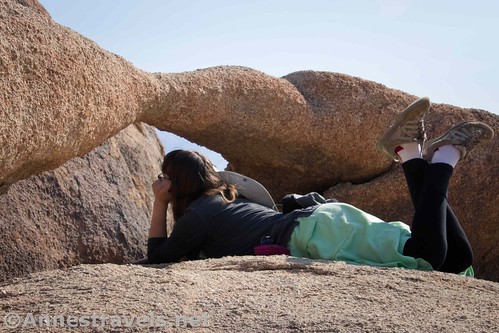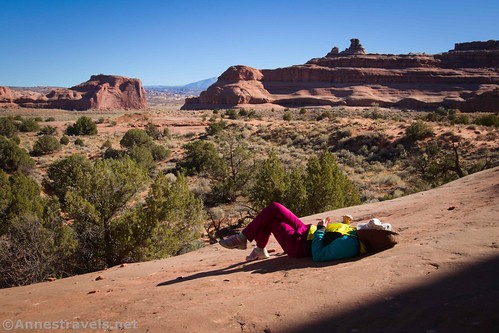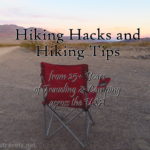
This is a guest post.
I’ve always sort of prided myself on being able to eat ‘whatever’ when I was on the trail. I don’t generally suffer from not feeling like eating when hiking or anything like that. (I even used to put raspberry jam on pasta leftover from last night’s supper as a trail snack!). I liked being able to eat whatever I needed to when I was hiking.
So it was pretty annoying when, about three years ago, I discovered that I was lactose intolerant. Fortunately, all I had to do was carry my dairy supplements with me wherever I went, and it wasn’t too annoying, although some of my favorite snacks (mozzarella cheese sticks being one example) had too much dairy for me to handle at one time. Still, it wasn’t too life-altering. On the mornings I ate cereal, I’d bring along shelf-stable almond milk while everyone else used cow’s milk. (The shelf-stable carton allowed me to not have to find almond milk in far-flung grocery stores – though it’s pretty easy to find these days.)
Then, two years later, I found out that I am also gluten intolerant.

Being gluten intolerant on the trail is just plain a pain in the neck. Most carb-heavy snacks have wheat in them, and even the weirdest things that you wouldn’t expect can have traces of wheat (which, depending on your level of intolerance, is ok or not – for me, it’s not). All of my favorite things that I was used to just popping in my mouth when I was hungry all seemed to have wheat in them…crackers, cookies, many types of granola bars – even peanut butter and jelly all of a sudden got really complicated! And the second really awful thing is that most gluten-free food just doesn’t taste as good.
Fortunately, there are plenty of options out there for those of us who are restricted in what we can eat. Some taste delicious, others taste like cardboard, and you just have to try them to find out which ones you like. Here are a few tips that I have learned for traveling and hiking with dietary restrictions:

First of all, when shopping…
- READ THE LABEL!!! You’d be amazed at the number of things you can’t eat…or can! If you suffer from gluten intolerance (or celiac), be wary of anything containing malts (they usually have barley in them, which contains gluten). Anything with barley, wheat, or rye contains gluten. Depending on your sensitivity, watch out for the words ‘may contain’ and act accordingly. Also, read Every. Single. Ingredient. You never know when a manufacturer will slip something in and not declare it on the front of the package.
- Try Walmart. They have a wide selection of gluten-and-dairy-free foods. Again, read the label to be sure, but if it’s labeled ‘gluten-free,’ ‘dairy-free,’ or whatever your restriction is, you should be fine. If you live in the eastern U.S. and have Wegmans nearby, their prices are usually a bit higher than Walmart’s, but they also tend to be very sensitive to dietary needs. Trader Joe’s is another good option. You can find diet-sensitive sections of stores pretty much anywhere (Kroger, Food Lion, and ALDI, just to name a few), but I especially like Walmart’s and Wegmans’ selections.
- Food that is easy to just ‘pop in’ your mouth when you’re on the trail can be difficult to come by. Granola bars are a good option, but watch out for potential trouble with the ingredients. Many granola bars contain wheat, soy, peanuts, dairy, or all of the above. I personally really like Bobo’s oat bites – they come in a lot of different flavors, and I haven’t found any that I don’t care for (I get these at Walmart, but they’re also available on the manufacturer’s website and many grocery stores – I even found them in the City Market in Moab, Utah!) Nature’s Bakery’s fig bars are another great option that aren’t quite as sweet as most granola bars. They’re naturally dairy-free, and you can get a gluten-free option, too (I also get these at Walmart).
- Gluten-free food tends to be crumbly. That’s something you should think about if you’re planning to take it on the trail. It’s best to go for foods that hang together a bit better so that you’re not trying to eat a pile of crumbs. (Crackers are a bad idea, just for example.)
- Rice cakes are another really good option. They’re a bit larger than some of the things I’ve mentioned, and they can be a bit crumbly, but they’re also really versatile. Quaker Oats sells them in about a dozen different flavors (watch out, though, as some of them do contain dairy). The plain ones can be eaten with peanut butter for a snack high in protein. Which leads me to…
- Nuts are your friend (just check the label because some ‘may contain’ any number of different potential allergens). It’s really important to make sure that your diet is full of protein when you’re hiking just in general, and I’ve found it to be doubly important with my dietary restrictions. I find that a lot of gluten-free stuff just doesn’t fill me up or give me the energy that I need. I eat a LOT of peanut butter and jelly on the trail, mostly on gluten-free bread (Sam’s Choice is my choice). Most brands of peanut butter are gluten-and-dairy-free, and a lot of them are soy-free as well. (Obviously, this doesn’t help if you have a nut allergy. See #7 for other good ways to get protein in your hiking diet.)
- Bologna and other types of deli meat can be a good way to get protein on the trail as long as you’re not planning on being out for more than a day. Canned chicken isn’t very flavorful, but I know people who eat it in a sandwich with mustard. If you’re not dairy-intolerant, cheese sticks are another great option.
- Vegan options can be good if you’re dairy-intolerant. Check the label, but there *shouldn’t* be any dairy in vegan foods.
- Don’t go with frozen bread if you’re gluten-intolerant. Not only is it very fragile and messy when you’re trying to hike, but I also don’t personally think it’s as good just in general. My favorite type to hike with is Sam’s Choice multigrain gluten-free bread from Walmart (the white bread of the same brand is good too and doesn’t leave millet seeds everywhere…)
- Fruit and vegetables are always safe. Clementines, apples, grapes, or whatever else you can think of to take on the trail are good options for a tasty snack along the way. I also like carrot sticks. These aren’t always very practical for long trips, but if you are able to tote them along without refrigeration, I’ve found them to be pretty good.
- When you’re shopping, just be aware that diet-sensitive food tends to be more expensive, so budget for that. As much as possible, try to go for foods that you’re familiar with (you don’t want to test things out on the trail in case something tastes horrible or you have some unexpected reaction).

And when you’re on the trail…
- Know your body. Know what you can and can’t handle and lean on the safe side of your diet. You don’t want to be throwing up while hiking because you got something in your diet that you didn’t realize was going to be an issue.
- If you’re hiking with a group and you have a communal lunch box, you will probably have to rethink this for yourself. I discovered that I could store my gluten-free bread in a sandwich bag inside my pack. When I would take bologna with me, I would put the sandwich together in the morning and slip the whole thing inside the sandwich bag. When lunchtime rolled around, all I had to do was pull the sandwich out and eat it. Try to make sure that your hiking friends know you’re not a snob by insisting on carrying your own food – you just want to feel good enough to finish the hike.
- Pack plenty to eat. As I mentioned earlier, many diet-sensitive snacks don’t fill me up as much as regular ones, so I’ve found that I needed to actually eat more on the trail.
- Make sure that someone else in your group has something that you can eat in a pinch. Even if it’s not something you’d normally go for, making sure that you’re not the only person carrying something that you can eat in case of an emergency is a good idea. I mean, it’s not too likely that you’re going to lose your pack in the middle of nowhere, but it’s better to be safe than sorry…
- Pay attention to your body. If it’s telling you that it’s not liking what you’re eating for whatever reason, don’t force it. Be sensitive to what it needs regardless of what the packaging on your food says.
- Carry supplements with you. If your dietary restriction can be cured with a supplement, great! Just make sure you’ve got them with you. I always carry some in with my driver’s license and other personal items that I’m not going to leave behind in case I forget the whole package or something. You don’t want to be out on the trail and suddenly realize that you can’t eat half your snacks. And in case of an emergency and you have to eat something that you wouldn’t normally eat, it’s good to have them on you.
- Watch out for reusing utensils that others have used. For example, use your own butter knife for spreading peanut butter if someone else has used it on regular bread before you use it on your gluten-free option, don’t share food preparation surfaces, etc.
- Let your group members know what your restrictions are so that they can help you be careful. Communication can be the difference between accidental contamination and your hiking comfort.
- When in doubt, don’t eat it unless there’s an emergency.

If you’re hiking with someone with an allergy…
- Give the person special grace. This isn’t their ideal way of living, either. Don’t ask me how I know this…
- Be sensitive. If they want to carry their own food, fine. If they ask you to carry an extra snack so all of their eggs aren’t in one basket, so to speak, fine. If they need to run out to the store because they have no more snacks they can eat, fine.
- Let them have their own utensils and cooking surfaces, or let them go first so that their food is uncontaminated.
- If they don’t have the energy that they did before discovering the allergy, be patient. They’re not feeling great and having you stop to take numerous pictures of the scenery may be exactly what they need!
- Let them choose their own food – they may appreciate it if you think of them and provide them with food that fits their diet, but most would rather supply their own food so they know exactly what’s in it.
- Don’t be offended if they don’t want to eat something, no matter how much you can certify that it’s fine for them. They may be leaning on the side of caution so they don’t have a reaction in the middle of the wilderness. They’re not trying to be offensive!
Hiking with a dietary restriction can be a big pain, but there are a lot of options out there. We’re fortunate to live in an age when a lot of stores are aware of dietary restrictions and sell things accordingly. While these things may be more expensive, it’s worth it to feel good while you’re hiking!
Sarah Grace has been hiking with me since… well, since I was carrying her in the front pack in our local park a few weeks after her birth. Check out her website at: https://thewingsofheaven.weebly.com/
This Week’s Featured Product!
It usually takes a food allergy to create a book on food allergies, and Sarah was no different. After learning how to cook for her son while on the trail, she shares her expertise and recipes for people with food allergies, intolerances, and restrictions.






